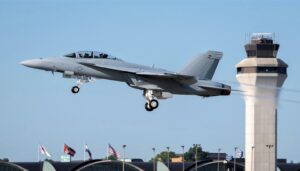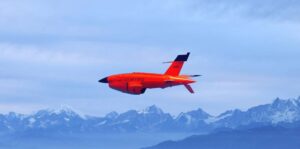Boeing [BA] and the Navy successfully tested a Block III F/A-18E/F Super Hornet controlling three unmanned aerial vehicles (UAVs) in manned-unmanned teaming (MUM-T) flight tests in 2021, the company announced on July 15.
During a two week period of test fights, Super Hornet pilots entered commands into a third-party tablet, which were processed and transmitted through the Block III hardware. Boeing said the UAVs executed all commands given by the pilots.

Company system engineers connected the Super Hornet Block III’s adjunct processor, the Distributed Targeting Processor-Networked (DTP-N) with an unspecific third-party tablet to team the aircraft with three Northrop Grumman [NOC] BQM-34 unmanned aerial vehicles.
The BQM-34 Firebee is primarily used by the military to simulate tactical enemy aircraft and missile threats in training and weapon system evaluation. It can fly up to Mach 0.97 and up to 60,000 feet.
The Block III Super Hornet improvements include the DTP-N, extending vehicle lifespan from 6,000 to 10,000 flight hours, a smaller radar signature, upgrades to the Lockheed Martin [LMT] Block II Infrared Search and Track System (IRST) sensor, upgrades to the Active Electronically Scanned Array, an advanced cockpit system, and enhanced communications systems.
The company noted it developed new software loads for the DTP-N to specifically run the third party tablet and allow the pilot to transmit commands to the UAVs. Boeing said software development, tablet connection to the fighter, and flight tests were finished in under six months.
Boeing said the test is an example of how DTP-N adds significant processing power to the F/A-18’s mission processing suite.
Navy spokesperson Connie Hempel told Defense Daily the demonstration took place in the fall of 2021. She noted that “throughout the demos, the pilot controlled all three UAVs at once as well as separately.”
The Super Hornet pilot specifically entered commands directing the UAVs to execute several autonomous maneuvers used in combat missions.

“The maneuvers included formation of flight, automatic reroute for a new designated no flight zone, and area of interest. The pilot monitored the mission’s progress and communicated with the UAVs via the human machine interface on the tablet. The flight demos used mission sensors on the Super Hornet and UAVs,” Hempel added.
In this demonstration, Boeing worked with the F/A-18 and EA-18G Program Office (PMA-265), Air Test and Evaluation Squadrons (VX) 23 and 31, Naval Air Warfare Center-Weapons Division at China Lake, Calif., and a third-party vendor on the demonstration.
“This successful MUM-T demonstration represents a significant step toward the Navy’s vision for Distributed Maritime Operations. It highlights the potential of unmanned concepts to expand and extend the Navy’s reach,” Scott Dickson, Boeing’s director for Multi-Domain Integration, said in a statement.
“As part of a Joint All-Domain Command and Control network, teams of UAV conducting ISR missions led by the latest Super Hornets equipped with network-enabled data fusion and advanced capabilities would provide warfighters across the Joint Force with significant information advantage,” he continued.
Similarly, Ben LeGrand, Boeing director of Mission Systems, boasted this proves the Block III Super Hornet can integrate third-party systems and software “with minimal modifications.”
“Future fighter pilots will be the quarterback of the skies, orchestrating commands and controlling UAVs from the integrated Block III touch-screen cockpit. Block III Super Hornet is the bridge to the future and is a risk reducer for the Navy that is delivering on teaming, networking and interoperability now,” Mark Sears, Boeing vice president and program manager of F/A-18 and EA-18G programs, added.